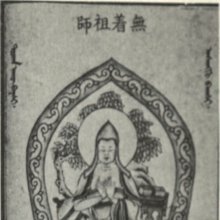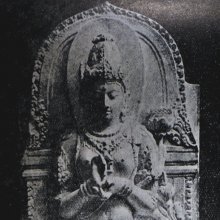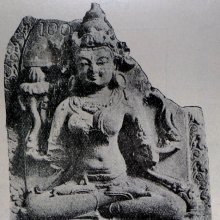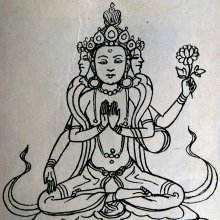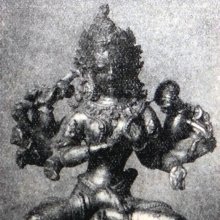Asanga, Āsaṅga, Asaṅga, Asamga: 27 definitions
Introduction:
Asanga means something in Buddhism, Pali, Hinduism, Sanskrit, Jainism, Prakrit, Marathi. If you want to know the exact meaning, history, etymology or English translation of this term then check out the descriptions on this page. Add your comment or reference to a book if you want to contribute to this summary article.
Images (photo gallery)
(+2 more images available)
In Hinduism
Purana and Itihasa (epic history)
Source: archive.org: Shiva Purana - English TranslationAsaṅga (असङ्ग) refers to “one who is without attachment” and is used to describe Śiva, according to the Śivapurāṇa 2.3.25 (“The seven celestial sages test Pārvatī”).—Accordingly, as the seven Sages said (with false words) to Pārvatī: “[...] He [Śiva] is single without a second and without attachment [i.e., asaṅga]. He is after salvation, O gentle lady, how can a woman put up with him. O blessed one, even now, at our bidding, return to your house. Cast off this foolish intention. You will benefit thereby. [...]”.
Source: Cologne Digital Sanskrit Dictionaries: The Purana Index1) Asaṅga (असङ्ग).—The son of Yuyudhāna.*
- * Matsya-purāṇa 45. 23.
2) Āsaṅga (आसङ्ग).—The son of Śvaphalka and Gāndini.*
- * Bhāgavata-purāṇa IX. 24. 16.

The Purana (पुराण, purāṇas) refers to Sanskrit literature preserving ancient India’s vast cultural history, including historical legends, religious ceremonies, various arts and sciences. The eighteen mahapuranas total over 400,000 shlokas (metrical couplets) and date to at least several centuries BCE.
Yoga (school of philosophy)
Source: ORA: Amanaska (king of all yogas): A Critical Edition and Annotated Translation by Jason Birch1) Asaṅga (असङ्ग) refers to “that which is unattached”, according to the Bṛhadāraṇyikopaniṣat 3.8.6, 8.—Accordingly, while describing the absolute nature of Brahma: “Gārgi said, ‘Yājñavalkya, that which is above the sky, below the earth, between the two and called [past, present and future], is stitched and cross-stitched in what?’ Yājñavalkya said, ‘Gārgi, the Brahmins call that very [thing] the imperishable one. [It is] not coarse, not particulated, not short, not long, bloodless, unlubricated, shadowless, undarkened, windless, spaceless, unattached (asaṅga), tasteless, scentless, invisible, inaudible, speechless, mindless [...]’”.
2) Āsaṅga (आसङ्ग) refers to “attachment (to sense objects)”, according to the Sarvajñānottara 29.40.—Accordingly, while describing the no-mind state: “Having thrown off attachment to sense objects (viṣaya-āsaṅga), one should [thus] eliminate one's mental activity. When one goes to the state of no mind, then that is the supreme bliss”.

Yoga is originally considered a branch of Hindu philosophy (astika), but both ancient and modern Yoga combine the physical, mental and spiritual. Yoga teaches various physical techniques also known as āsanas (postures), used for various purposes (eg., meditation, contemplation, relaxation).
In Buddhism
Tibetan Buddhism (Vajrayana or tantric Buddhism)
Source: Google Books: Mahāmudrā and Related InstructionsAsaṅga (असङ्ग) is the name of an ancient teacher belonging to the “lineage of vast conduct”, according to “the succession of Gurus in the Mahāmudrā lineages” in the Kagyü School of Tibetan Buddhism (the Mahāmudrā deals with the nature of the mind).—The graduated path of the three levels of beings, which is an adornment [for the Mahāmudrā], is of three lineages: 1. The lineage of vast conduct; 2. The lineage of the profound view; 3. The lineage of the blessing of practice.—[The lineage of vast conduct]—(1) The Lord of Sages [the Buddha], ... (3) Asaṅga,... and (14) Atiśa Dīpaṃkara.
Source: archive.org: The Indian Buddhist IconographyAsaṅga (असङ्ग) was a brother of Vasubandhu (280-360 A. D.) and a practitioner of Tantric Buddhism.—Tārānātha (Tārānāth) is reported to have said that Tantrism existed from very early times and was transmitted in a secret manner from the time of Asaṅga down to the time of Dharmakīrti. Asaṅga who was a brother of Vasubandhu (280-360 A. D.) must have flourished circa 300 A. D. and Dharmakīrti who is not mentioned by the Chinese traveller Hiuen Thsang but is referred to with great respect by I-Tsing very probably belonged to a period between 625-675 A. D.

Tibetan Buddhism includes schools such as Nyingma, Kadampa, Kagyu and Gelug. Their primary canon of literature is divided in two broad categories: The Kangyur, which consists of Buddha’s words, and the Tengyur, which includes commentaries from various sources. Esotericism and tantra techniques (vajrayāna) are collected indepently.
Mahayana (major branch of Buddhism)
Source: archive.org: Bulletin of the French School of the Far East (volume 5)Asaṅgā (असङ्गा) [?] is the name of a Rākṣasī appointed as one of the Divine protector deities of Chan-chan, according to chapter 17 of the Candragarbha: the 55th section of the Mahāsaṃnipāta-sūtra, a large compilation of Sūtras (texts) in Mahāyāna Buddhism partly available in Sanskrit, Tibetan and Chinese.—In the Candragarbhasūtra, the Bhagavat invites all classes of Gods and Deities to protect the Law [dharma?] and the faithful in their respective kingdoms of Jambudvīpa [e.g., the Rākṣasī Asaṅgā in Chan-chan], resembling the time of the past Buddhas.
Source: academia.edu: A Study and Translation of the Gaganagañjaparipṛcchā1) Asaṅga (असङ्ग) refers to “non-attachment”, according to the Gaganagañjaparipṛcchā: the eighth chapter of the Mahāsaṃnipāta (a collection of Mahāyāna Buddhist Sūtras).—Accordingly, “Then the Bodhisattva Gaganagañja, having praised the Lord with these verses, addressed himself to the Lord: ‘[...] If, Lord, the Tathāgata gives some advice about the entrance into the analysis of the dharma to me, I would ask a question. Why is that? The Lord, having obtained the knowledge of non-attachment (asaṅga), is skilled in knowing the excellent and not so excellent abilities in all living beings. The Lord, having obtained the light, is free from the all darkness. [...]’”.
2) Asaṅga (असङ्ग) refers to the “unattached” (e.g., ‘one who knows the unattached knowledge of the three times’), according to the Gaganagañjaparipṛcchā.—Accordingly, “How then, son of good family, does the Bodhisattva appear to many beings performing the deeds of a Buddha (buddhakārya) even when the Buddhas do not appear? Son of good family, [...] (2) he has perfected the purification of the four fearlessness by knowing the cessation of impurities; (3) he has perfected the purification of the eighteen special qualities of the Tathāgata by knowing the unattached knowledge of the three times (tryadhva-asaṅga); [...]”.

Mahayana (महायान, mahāyāna) is a major branch of Buddhism focusing on the path of a Bodhisattva (spiritual aspirants/ enlightened beings). Extant literature is vast and primarely composed in the Sanskrit language. There are many sūtras of which some of the earliest are the various Prajñāpāramitā sūtras.
General definition (in Buddhism)
Source: Buddhist Door: GlossaryBrother of Vasubandhu. Originally trained as a Hinayanist, but converted his brother Vasubandha to become Mahayanist. They both established the Yogacara School of Buddhism.
Source: Buddhism Tourism: Glossary of Buddhist TermsThe Buddhist who established the Yogcara School of Buddhism. He is considered the author of Mahayanasamgraha, Abhidharmasamuccaya and a commentary on the Samdhinirmocana.
Source: academia.edu: The Chronological History of BuddhismAsaṅga (असङ्ग).—According to Tibetan sources, Asaṅga (965-900 BCE) and Vasubandhu (963-883 BCE) were half-brothers from Puruṣapura of Gāndhāra Janapada and born 900 years after Buddha nirvana. Asaṅga’s father was a Kśatriya whereas Vasubandhu’s father was a Brāhmaṇa. Prasannaśīlā was the mother of Asaṅga and Vasubandhu. Professor J. Takakusu published “The Life of Vasubandhu by Paramārtha” in the year 1904. It is a translation from a Chinese manuscript. It states that a Kauśika Brāhmaṇa family of Puruṣapura (Peshawar) had three sons, Asaṅga, Vasubandhu and Viriñchivatsa. Asaṅga studied Hīnayāna texts from Arhat Pindola and also studied Mahāyāna texts. Hiuen Tsang mentions that Asaṅga initially followed Mahishasaka sect of Buddhism but later he became Mahayanist.
In Jainism
General definition (in Jainism)
Source: Wisdom Library: JainismAsanga (असन्ग) is the Prakrit name of a Yakṣa chief, obiedient to Vaiśramaṇa (god of wealth, also known as Kubera), according to the Bhagavatī-sūtra, also known as The Vyākhyāprajñapti (“Exposition of Explanations”). The Bhagavatī-sūtra is the largest of twelve Jain āgamas and was composed by Sudharmāsvāmī in the 6th century.

Jainism is an Indian religion of Dharma whose doctrine revolves around harmlessness (ahimsa) towards every living being. The two major branches (Digambara and Svetambara) of Jainism stimulate self-control (or, shramana, ‘self-reliance’) and spiritual development through a path of peace for the soul to progess to the ultimate goal.
Languages of India and abroad
Pali-English dictionary
Source: BuddhaSasana: Concise Pali-English Dictionaryasaṅga : (m.) non-attachment.
Source: Sutta: The Pali Text Society's Pali-English DictionaryAsaṅga, (adj.) (a + saṅga) not sticking to anything, free from attachment, unattached Th. 2, 396 (°mānasa, = anāsattacitta ThA. 259); Miln. 343. Cp. next. (Page 87)
— or —
Āsaṅga, (ā + saṅga fr. sañj to hang on, cp. Sk. āsaṅga & āsakti) — 1. adhering, clinging to, attachment, pursuit J. IV, 11.—2. that which hangs on (the body), clothing, garment, dress; adj. dressed or clothed in (-°); usually in cpd. uttarāsaṅga a loose (hanging) outer robe e.g. Vin. I, 289; S. IV, 290; PvA. 73; VvÁ 33 (suddh°), 51 (id.). (Page 114)

Pali is the language of the Tipiṭaka, which is the sacred canon of Theravāda Buddhism and contains much of the Buddha’s speech. Closeley related to Sanskrit, both languages are used interchangeably between religions.
Marathi-English dictionary
Source: DDSA: The Molesworth Marathi and English Dictionaryasaṅga (असंग).—a (S) Lone, solitary, wanting a companion. 2 That is not to be associated with. Pr. asaṅgāsīṃ saṅga prāṇāsīṃ gāṇṭha.
--- OR ---
asaṅga (असंग).—m (S) Absence or nonness of companionship.
Source: DDSA: The Aryabhusan school dictionary, Marathi-Englishasaṅga (असंग).—a Lone; that is not to be associa- ted with. m Absence of companion- ship.
Marathi is an Indo-European language having over 70 million native speakers people in (predominantly) Maharashtra India. Marathi, like many other Indo-Aryan languages, evolved from early forms of Prakrit, which itself is a subset of Sanskrit, one of the most ancient languages of the world.
Sanskrit dictionary
Source: DDSA: The practical Sanskrit-English dictionaryĀsaṅga (आसङ्ग).—a. Uninterrupted, perpetual. [-gaḥ]
1) Attachment, devotion (to any object) (to enjoy or protect it); सुख° लुब्धः (sukha° lubdhaḥ) K.173; Uttararāmacarita 3; चेतः स्वर्गतरङ्गिणीतटभुवामासङ्ग- मङ्गीकुरु (cetaḥ svargataraṅgiṇītaṭabhuvāmāsaṅga- maṅgīkuru) Bhartṛhari 3.6.
2) Intentness, close application.
3) Contact, adherence, clinging; (paṅkajam) सशैवलासङ्गमपि प्रकाशते (saśaivalāsaṅgamapi prakāśate) Kumārasambhava 5.9;3.46; व्रततिवलयासङ्गसंजातपाशः (vratativalayāsaṅgasaṃjātapāśaḥ) Ś.1.33; Mu.1.14; अनासङ्गः (anāsaṅgaḥ) absence of consolation; Mālatīmādhava (Bombay) 2.
4) Association, connection, union; त्यक्त्वा कर्मफलासङ्गम् (tyaktvā karmaphalāsaṅgam) Bhagavadgītā (Bombay) 4.2; so कान्तासङ्ग (kāntāsaṅga) &c.
5) Fixing, fastening to.
6) Pride about the authorship of a thing (kartṛtvābhimāna),
7) That which is fastened; cf. उत्तरासङ्ग (uttarāsaṅga).
8) Waylaying (?).
-ṅgam A kind of fragrant earth (saurāṣṭramṛttikā).
-ṅgam ind. Without interruption, eternally.
Source: Cologne Digital Sanskrit Dictionaries: Edgerton Buddhist Hybrid Sanskrit DictionaryAsaṅga (असङ्ग).—(1) name of an author: Sādhanamālā 325.4 (= 3?); (2) name of a yakṣa: Mahā-Māyūrī 43; (3) see Āryāsaṅga.
Source: Cologne Digital Sanskrit Dictionaries: Shabda-Sagara Sanskrit-English DictionaryAsaṅga (असङ्ग).—mfn.
(-ṅgaḥ-ṅgā-ṅgaṃ) Solitary, unassociated. E. a neg. saṅga with.
--- OR ---
Āsaṅga (आसङ्ग).—m.
(-ṅgaḥ) 1. Attachment to any object. 2. Association, connexion. 3. Proximity, contact. adv. n.
(-ṅgaṃ) Eternally. adj. mfn.
(-ṅgaḥ-ṅgā-ṅgaṃ) Eternal. E. āṅ always, ṣañj to move, ac aff.
Source: Cologne Digital Sanskrit Dictionaries: Benfey Sanskrit-English DictionaryĀsaṅga (आसङ्ग).—i. e. ā-sañj + a, m. 1. Being attached, [Śākuntala, (ed. Böhtlingk.)] [distich] 132. 2. Attachment, [Pañcatantra] v. [distich] 93.
--- OR ---
Asaṅga (असङ्ग).—I. m. 1. non-attachment, not being attached to, [Mānavadharmaśāstra] 6, 75. 2. a proper name, [Harivaṃśa, (ed. Calc.)] 9207. Ii. adj. 1. unfastened, Mahābhārata 2, 944. 2. unimpeded, [Raghuvaṃśa, (ed. Stenzler.)] 3, 63 (Mallin., ed. Calc. v. r.).
Asaṅga is a Sanskrit compound consisting of the terms a and saṅga (सङ्ग).
Source: Cologne Digital Sanskrit Dictionaries: Cappeller Sanskrit-English DictionaryAsaṅga (असङ्ग).—1. [masculine] not sticking to (—°).
--- OR ---
Asaṅga (असङ्ग).—2. asaṅga [adjective] not sticking or hanging, moving freely, independent.
--- OR ---
Asaṅga (असङ्ग).—[adjective] not sticking or hanging, moving freely, independent.
--- OR ---
Āsaṅga (आसङ्ग).—[masculine] = [preceding] [feminine]
Source: Cologne Digital Sanskrit Dictionaries: Monier-Williams Sanskrit-English Dictionary1) Asaṅga (असङ्ग):—[=a-saṅga] mfn. or a-saṅga free from ties, independent, [Śatapatha-brāhmaṇa xiv] ([Bṛhad-āraṇyaka-upaniṣad]), [Nṛsiṃha-tāpanīya-upaniṣad]
2) [v.s. ...] moving without obstacle (as a cart, a vessel, a flag, etc.), [Mahābhārata ii, 944; Harivaṃśa] etc.
3) [v.s. ...] having no attachment or inclination for or interest in
4) [v.s. ...] (See also sub voce a-sakta)
5) [v.s. ...] m. non-attachment, non-inclination, [Manu-smṛti vi, 75; Bhāgavata-purāṇa]
6) [v.s. ...] Name of a son of Yuyudhāna, [Harivaṃśa 9207; Viṣṇu-purāṇa]
7) [v.s. ...] a Name of Vasubandhu, [Buddhist literature]
8) Āsaṅga (आसङ्ग):—[=ā-saṅga] [from ā-sañj] m. the act of clinging to or hooking on, association, connection, [Śakuntalā; Kumāra-sambhava; Bhāgavata-purāṇa] etc.
9) [v.s. ...] attachment, devotedness, [Sāhitya-darpaṇa; Kathāsaritsāgara] etc.
10) [v.s. ...] waylaying, [Ṛg-veda; Śatapatha-brāhmaṇa]
11) [v.s. ...] Name of a man, [Ṛg-veda viii, 1, 32; 33]
12) [v.s. ...] of a son of Śva-phalka, [Bhāgavata-purāṇa ix, 24, 15]
13) [v.s. ...] a cloak (see citrās°, p. 397)
14) [v.s. ...] a sword, [cf. Lexicographers, esp. such as amarasiṃha, halāyudha, hemacandra, etc.]
15) [v.s. ...] one of the 7 islands of Antara-dvīpa, [cf. Lexicographers, esp. such as amarasiṃha, halāyudha, hemacandra, etc.]
16) [v.s. ...] n. a kind of fragrant earth, [cf. Lexicographers, esp. such as amarasiṃha, halāyudha, hemacandra, etc.]
17) [v.s. ...] mfn. uninterrupted, [cf. Lexicographers, esp. such as amarasiṃha, halāyudha, hemacandra, etc.]
Source: Cologne Digital Sanskrit Dictionaries: Yates Sanskrit-English Dictionary1) Asaṅga (असङ्ग):—[a-saṅga] (ṅgaḥ-ṅgā-ṅgaṃ) a. Alone.
2) Āsaṅga (आसङ्ग):—[ā-saṅga] (ṅgaḥ-ṅgā-ṅgaṃ) a. Eternal.
Source: DDSA: Paia-sadda-mahannavo; a comprehensive Prakrit Hindi dictionary (S)Asaṅga (असङ्ग) in the Sanskrit language is related to the Prakrit words: Asaṃga, Āsaṃga.
[Sanskrit to German]
Sanskrit, also spelled संस्कृतम् (saṃskṛtam), is an ancient language of India commonly seen as the grandmother of the Indo-European language family (even English!). Closely allied with Prakrit and Pali, Sanskrit is more exhaustive in both grammar and terms and has the most extensive collection of literature in the world, greatly surpassing its sister-languages Greek and Latin.
Prakrit-English dictionary
Source: DDSA: Paia-sadda-mahannavo; a comprehensive Prakrit Hindi dictionary1) Asaṃga (असंग) in the Prakrit language is related to the Sanskrit word: Asaṅga.
2) Āsaṃga (आसंग) also relates to the Sanskrit word: Āsaṅga.
Prakrit is an ancient language closely associated with both Pali and Sanskrit. Jain literature is often composed in this language or sub-dialects, such as the Agamas and their commentaries which are written in Ardhamagadhi and Maharashtri Prakrit. The earliest extant texts can be dated to as early as the 4th century BCE although core portions might be older.
Kannada-English dictionary
Source: Alar: Kannada-English corpusAsaṃga (ಅಸಂಗ):—[adjective] not mixed or mixing with (others); not associated with; being aloof; tending to be alone or reserved.
--- OR ---
Asaṃga (ಅಸಂಗ):—[adjective] a man not mingling with others or being reserved.
--- OR ---
Āsaṃga (ಆಸಂಗ):—
1) [noun] something one does in addition to a vocation or regular work, and purely for pleasure or self-satisfaction; hobby; avocation.
2) [noun] relation a) the connections or dealings between or among persons in business or private affairs; b) sexual intercourse; c) the connections or dealings between or among groups, peoples, nations, states, etc.
3) [noun] the quality of sticking; adhesiveness.
Kannada is a Dravidian language (as opposed to the Indo-European language family) mainly spoken in the southwestern region of India.
See also (Relevant definitions)
Starts with (+29): Acankai, Acankaiyan, Acankam, Acankamam, Acankan, Acankatam, Acankati, Acankauyatu, Asamgahiya, Asamgahiya, Asamgataka, Asamgatate, Asamgatokti, Asangabahula, Asangabaladharin, Asangabalaviryamati, Asangabuddhi, Asangacarin, Asangachitta, Asangacitta.
Ends with (+95): Abhyasamga, Adhikaprasamga, Adhyatmikasanga, Advarasanga, Aippasamga, Akshobhyasamga, Amritasanga, Anasanga, Anavasthaprasamga, Angasanga, Anishtaprasanga, Anushthanaprasanga, Apasanga, Aprasanga, Arasamga, Aryasanga, Ashtadashanga, Atiprasanga, Atmasamga, Avashanga.
Full-text (+182): Asamga, Playogi, Uttarasanga, Asangam, Vasubandhu, Pratyasanga, Cittasanga, Asang, Parasanga, Indriyasanga, Asangakashtha, Asamgi, Buddhadasa, Anasanga, Dyumni, Asangacarin, Anasa, Bodhisattvabhumisutra, Uttaracankam, Abhidharmasamuccaya.
Relevant text
Search found 58 books and stories containing Asanga, Āsaṅga, Asaṅga, Asamga, A-sanga, A-saṅga, Ā-saṅga, Asaṃga, Āsaṃga; (plurals include: Asangas, Āsaṅgas, Asaṅgas, Asamgas, sangas, saṅgas, Asaṃgas, Āsaṃgas). You can also click to the full overview containing English textual excerpts. Below are direct links for the most relevant articles:
Rig Veda (translation and commentary) (by H. H. Wilson)
Maha Prajnaparamita Sastra (by Gelongma Karma Migme Chödrön)
Appendix 5 - The body of the Dharma (dharmakāya) < [Chapter XXVI - Exertion]
I. Text of the list according to the Prajñāpāramitā < [Part 1 - Mahāyānist list of the eighteen special attributes of the Buddha]
Preliminary note (1): The eighteen āveṇikadharmas of the Buddhas < [Chapter XLI - The Eighteen Special Attributes of the Buddha]
Blue Annals (deb-ther sngon-po) (by George N. Roerich)
Chapter 3d - The Life story of Mon ston byung gnas shes rab < [Book 4 - New Traditions of Secret Mantra]
Book 6 - The Origin of the Mādhyamika (middle way)
Chapter 3e - The Life Story of the Ācārya 'Phags pa < [Book 4 - New Traditions of Secret Mantra]
Garga Samhita (English) (by Danavir Goswami)
Verse 5.20.25 < [Chapter 20 - The Liberation of Ṛbhu Muni During the Rāsa-dance Festival]
Shrimad Bhagavad-gita (by Narayana Gosvami)
Verse 4.20 < [Chapter 4 - Jñāna-Yoga (Yoga through Transcendental Knowledge)]
Verses 15.3-4 < [Chapter 15 - Puruṣottama-toga (Yoga through understanding the Supreme Person)]
Verse 15.6 < [Chapter 15 - Puruṣottama-toga (Yoga through understanding the Supreme Person)]
Sahitya-kaumudi by Baladeva Vidyabhushana (by Gaurapada Dāsa)
Text 11.44 < [Chapter 11 - Additional Ornaments]
Related products
